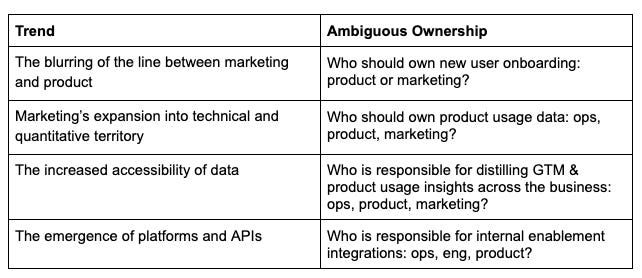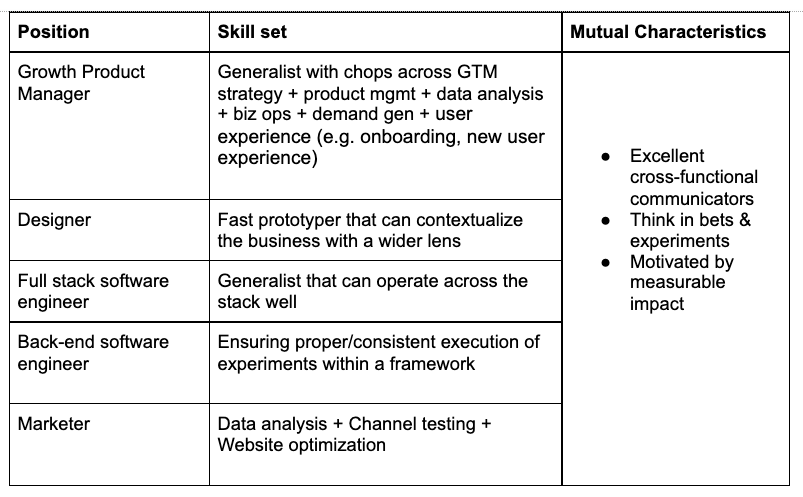Growth Teams Part 1
This is Part 1 in a Series of posts that Fynn Glover and I will co-publish together. Fynn & I have known each other & worked together for a long time, and our better halves often tell us that we need to seek couples therapy. That said, we have a good time sparring with one another, and it was fun to write an article together.
In this post, we’ll explore the rise of growth teams within high-growth technology companies, how they’re commonly structured, what they typically do, and some of our own experience defining a growth function at Automox.
Though this post won’t travel too far back in time, it will briefly examine recent history, and the shifts that are taking place within technology companies that have led to the rise of growth teams.
The Origins of Growth
Investments in Growth teams at software companies have grown in popularity over the past few years.
Brian Balfour, former VP of Growth at Hubspot and now founder/CEO of Reforge, an online learning company for growth leaders, explained the rise of growth teams as a result of several trends across technology companies:
- the blurring of the line between marketing and product
- marketing’s expansion into technical and quantitative territory
- the increased accessibility of data
- the emergence of platforms and APIs
Underlying each of these trends is a desire to accelerate growth rate by releasing the constraints caused by functional silos, or, put differently, to release the constraints caused by ambiguous ownership.

For more information on the history of growth, we’ve enjoyed the following pieces:
- Growth Wins
- Growth Frameworks from Andy Johns
- Building Growth Teams
- The most important growth metrics (TL;DR, it’s retention)
How Growth Teams are Structured
A commonly used playbook is to hire a cross-functional tiger team. This is entirely dependent on the challenges the specific company faces, but regardless is a good kernel that consists of some combination of the following skill sets & positions:

Depending on the resources & size of the company, as well as the skillset of the Growth PM, a director or VP position & skill set can be advantageous.

The benefits of this setup are a few-fold:
- The first is that it creates a situation in which the director and the PM work as thought partners to impact the business across a broader surface area.
- The second is that the team is capable of systematizing the discovery of bets, both incremental and asymmetric from across the org.
- The third is that the team is capable of designing experiments to test & execute those bets. In almost all cases, execution requires a combination of data analysis, campaign design, enablement, and product iteration. A team of this composition can execute all four types.
A Growth' Team’s First Job to be Done
In our experience, the growth team needs to accomplish 5 objectives within the first 30 days at the company:
- Synthesize what we refer to as the business’ Macro Minto - the business’ situation, its complications, the questions its trying to answer, and how its answering those questions
- Synthesize the business’ growth strategy & the primary constraints on growth using Drake’s Equation
- Learn and develop empathy for the unique history that has led to the current organizational design & influenced the company’s psychology & operational procedures
- Establish a coherent mental model around the customer — the jobs to be done they’re hiring the product to do and the alternative options available to them in the market.
- Build & maintain relationships across every department, & position the mission of growth clearly (whether near or long term) to the company so that executives are aligned with the team’s focus areas and ICs understand how to collaborate with the growth team
Defining the team’s charter
One of the central questions businesses and growth teams must answer together is how to define the mission and mandate of the growth team. This isn’t necessarily easy, given several factors:
- growth is relatively new as a position/department within org. charts
- it’s easy for growth to become nebulous or misunderstood within an organization, especially if there isn’t commitment and support across the executive team
- depending on their composition, growth teams can operate both persistently against a few isolated metrics (often truer in larger companies, where incremental optimization within the funnel has large impact), as well as in time-bound missions that accelerate practices where none may yet exist (often truer in smaller companies that are beginning to scale or in the early phase of their growth stage).
One of the best definitions of growth we’ve seen comes from Evan Peters, VP Growth Strategy @ Datadog.
“We build scalable systems to maximize growth. Starting with data analysis, we set top-line targets, design the org, direct investment, prioritize attention, enable the field, build process, operate, marshal resources and close the loop with KPIs.”
For some companies, the growth team’s mandate might be an obvious & recurring challenge (e.g. optimize MQL to SQL conversion rate).
For other companies, there may not be a clear & obvious functional area for the growth team to own, however, there is a persistent need to own choice challenges that are cross-functional and that don't sit cleanly in any one group (e.g. onboarding / activation).
In the latter scenario, the growth team needs to be more investigative to correctly define the team’s charter, based on then business’ unique needs and in the context of:
- Existing functional teams, who own primary KPIs
- Presumably numerous strategic challenges to address, requiring a fair degree of executive consensus building to inform the prioritization
- A possible reality that the business primarily needs gap filling, which can present thrashing challenges
When we joined Automox to build a growth discipline, our challenge was the latter. Our first mission was to define our charter to identify and act on choice challenges. In the next part, we'll talk about our approach, and in future posts, we may explore:
- Balancing mission-oriented and persistent ownership
- Building a growth process & discipline
- Productizing the growth function